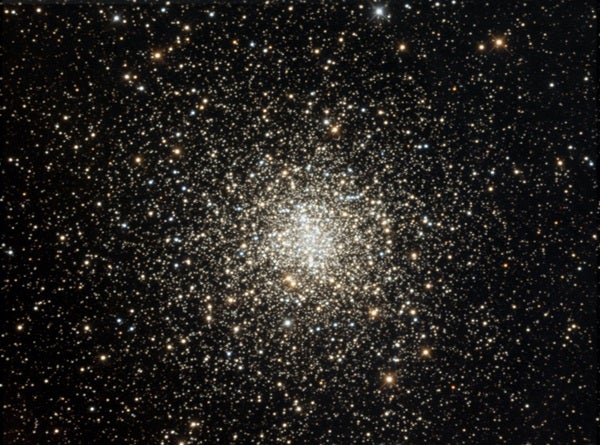Scorpius the Scorpion holds many of the sky’s finest deep-sky objects, including the spectacular globular cluster M4. This group of stars stands out for several reasons. First, at 7,200 light-years away, it is the closest globular cluster to our solar system. It’s also on the small side as globulars go, measuring about 75 light-years across. For comparison, the Hercules Cluster and the grandmaster of globulars, Omega Centauri, both span roughly 150 light-years in diameter.
Among the 100,000 or so stars that call M4 home is a hidden treasure: the pulsar PSR B1620−26. A member of a binary system, PSR B1620−26 is teamed up with a white dwarf. Researchers have confirmed that an exoplanet orbits these two stellar remnants. Because it is thought that planets form shortly after their parent stars, and because M4 is estimated to be around 12 billion to 13 billion years old, this is one of the oldest exoplanets yet found.
M4 earned a footnote in astronomical history by being the first globular cluster ever resolved. It was also the only globular out of the 29 included in Messier’s catalog that he was able to resolve into stars.
Best of all, it couldn’t be easier to find. M4 is nestled just over a degree west of brilliant Antares (Alpha [α] Scorpii), the heart of the Scorpion. Using low power, shift Antares so it’s just outside the eastern edge of your field and you’ll see the cluster’s spherical form take shape. Even an old 2.4-inch refractor can resolve some stars at 50x.
With a 4-inch aperture or larger, a curious feature appears. M4 displays a bright bar cutting right across the center of its disk, seemingly separating the cluster into two halves. Try a moderate magnification around 75x to 100x for the best view of this divide, which is the result of a chain of 11th-magnitude cluster stars that just happen to line up in a row.
Make sure to explore Astronomy’s full list of 101 cosmic objects you must see. New entries will be added each week throughout 2022.
To get the latest astronomical news and observing content delivered directly to your door, subscribe to Astronomy magazine today!










